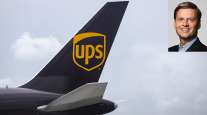UPS Earnings Soar 71% in 2Q; Firm Upbeat for Second Half
This story appears in the July 26 print edition of Transport Topics.
UPS Inc. “fired on all cylinders” in the second quarter, boosting profits and firming rates, despite spottiness in the global economic recovery, Chief Executive Officer Scott Davis said July 22.
“We continue to see strong momentum in 2010,” Davis said during an investor conference call last week. “UPS earnings jumped 71% on revenue growth of 13%, with improvement across all business units. This was achieved despite the fact that mixed economic signals continue to dominate the headlines,” he added.
UPS, Atlanta, said that in spite of continuing worries over sovereign debt crises in Europe and flagging consumer confidence in the United States, it earned $845 million, or 84 cents a share, in the second quarter. A year ago, the company earned $493 million, or 49 cents a share. Quarterly revenue rose to $12.2 billion from $10.8 billion.
UPS said its 2009 quarterly earnings excluded a $48 million after-tax charge related to adjustments in foreign currency.
Earnings growth was strongest in UPS’ international package business, where operating profit rose 77.8% to $521 million. Operating income in its domestic package business, which completed a significant restructuring during the quarter, rose 57.1% to $748 million.
The company’s supply chain and freight segment, which includes its less-than-truckload carrier, UPS Freight, had an operating income of $133 million in the quarter — a 5.6% improvement.
Throughout the quarter, UPS said, it kept busy with measures intended to firm-up rates across all of its business units.
“Our top priority for this year is stabilizing the pricing environment,” said Chief Financial Officer Kurt Kuehn. He said that, so far in 2010, UPS has managed to “sustain rate increases” without losing “significant” volumes from its customers.
The good news about rates extended to UPS Freight, the company said.
Freight’s LTL revenue-per-hundredweight, or yield, rose to $18.81 in the second quarter from $17.27 a year ago, UPS said.
Kuehn said Freight’s improved yield was likely “one of the industry’s best results.”
At least one stock analyst agreed.
“I think that’s probably the best number you’re going to see out of the LTL group” in the quarter, said David Ross, a Baltimore analyst who follows transportation stocks for Stifel, Nicolaus & Co. Inc.
The 2010 second quarter also was the first quarter of the past six that UPS Freight’s operations turned a profit, the company said. UPS does not publish Freight’s operating income, but the company did say that the LTL’s revenue rose 6.6% to $502 million.
UPS Freight handled fewer shipments during the quarter, and total LTL tonnage declined, although the average weight of each shipment increased. Davis said that company moved heavier shipments in the quarter as industrial production outpaced the general economy, resulting in comparatively more shipments of heavier goods.
Total LTL shipments declined 4.1% to about 2.5 million shipments in the quarter. UPS Freight hauled about 1.3 million tons in the quarter, down 2.2% from last year. Average weight per shipment was 1,065 pounds, up 1.9% year-over-year.
Also during the second quarter, UPS finished restructuring its U.S. package business. Under a plan that wrapped up late in the second quarter, UPS consolidated its domestic parcel network into 20 regions. UPS previously had cordoned off the United States into 46 regions.
The consolidation “is producing better than expected results,” Davis said, and “has started to pay dividends.” He estimated that, by 2011, the company would reap about 10 cents a share in benefits from the reorganization.
In the second quarter, however, costs related to the reorganization — training employees who took on new responsibilities and compensating those who were let go — reduced net earnings by about 2 cents a share, UPS said.
Looking ahead, UPS boosted its earnings guidance for 2010 to a range of $3.35 to $3.45 a share. The company previously had forecast that 2010 earnings would be in a range of $3.05 to $3.30 a share.
Citing reports from its supply chain and freight segment — which, among other tasks, arranges transportation for transoceanic freight — UPS said there was some evidence of modal shifts among shippers.
“Right now, there’s a little bit of an ocean squeeze; containers are harder to get,” Kuehn said. As a result, “we are seeing shippers planning to use a little more air.”
In spite of the rosier outlook, “our guidance is not assuming any dramatic economic uptick,” Kuehn said. “We think we’ll see volumes somewhere around GDP growth rates for the remainder of the year.”
Ross gave UPS credit for its positive outlook for what is likely to be a tougher second half.
“They’re still positive about their business,” he said.
As government stimulus programs expire later this year, Ross said, taxes could rise and consumer spending could taper off as a result, making it “more difficult going forward” for UPS to match the levels of growth it achieved in the second quarter.




